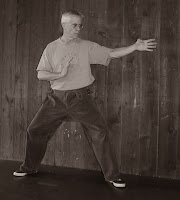 |
| Pulling the attacker down onto the front knee in Saifa kata. |
But sometimes, it's just not what you think. Goju-ryu is a system of 10 "classical" kata--and I am using the term classical loosely enough to include Sanchin and Tensho. So if this is the case, I would suggest, it's not what people often think or at least not the way you often see it practiced.
 |
| Attacking to the back of the opponent's neck in Seiunchin. |
For example: There is no upper target punch in Goju-ryu. And even though you can walk into almost any dojo in the world and find students practicing a jodan tsuki, you won't find it in the classical katas. We don't punch up to the head--we bring the head down to punch it. All you have to do is look at the classical subjects and this disconnect is apparent. In most dojos, we practice "basics" that include an upper target punch. Why not practice "basics" that are actually taken from the classical subjects, not some generic techniques that only conform to someone's expectations of karate? Why not practice techniques that actually prepare students for the movements in the classical subjects?
 |
| Blocking and kicking in Kururunfa kata. |
In fact, the forearm is probably used to strike more often than the standard punch or the back fist. And yet in most Goju-ryu dojos you can find people spending hour after hour punching the makiwara, until their knuckles are hard and calloused. Perhaps we should appropriate the "wooden man" from the Chinese martial arts and start pounding it with our forearms.
And while we're on the subject of confounding expectations...There are probably more knee kicks (hiza-geri) used in the bunkai of Goju-ryu kata than actual kicks with the foot. And the kicks with the foot are more targeted to the opponent's knees than higher--higher targets are easier to block--though when you watch students practice the front kick in most Goju-ryu dojos you will see front kicks waist high...and few knee kicks.
How about that ubiquitous technique: the mawashi-uke? The mawashi-uke seems to me--though this may seem blasphemous--deceptively not so much a "receiving" technique (though we refer to it as an "uke") as it is a finishing technique. In the classical katas, it occurs most often at the end of combinations, and it's usually used to twist the head--i.e. break the neck.
There's no half-fist strike or clam shell fist in Saifa, even though you will find it described that way in any number of books on Goju-ryu. (See Morio Higaonna's Traditional Karate-Do: Okinawa Goju Ryu, Vol. 1: The Fundamental Techniques.) And you will see it used to attack the throat or the opponent's ribs. But it's a grab. It's a half-fist to simulate the look of the hand as it grabs the opponent's collar bone or trapezius
 |
| Painting by Magritte |
And there's no cat stance (neko ashi dachi). That is, it doesn't seem to be used for anything; it merely signifies where you kick, whether with a knee kick or a front kick. If you think that statement is "out in left field," just try kicking every time you stand in cat stance in the classical katas. See what it opens up for you with bunkai.
And there's no spear hand or nukite strike in Shisochin...or elbow attacks for that matter.
Something to think about when you don't get bogged down with too many expectations.






































